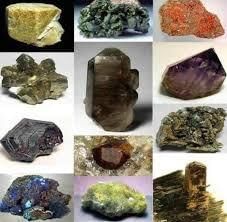Chhattisgarh: Minerals | Chhattisgarh State PSC (CGPSC) Preparation: All subjects - CGPSC (Chhattisgarh) PDF Download
| Table of contents |

|
| Introduction |

|
| Minerals in Chhattisgarh |

|
| Additional Minerals in Chhattisgarh |

|
| Directorate of Geology and Mining |

|
Introduction
- Chhattisgarh is one of India's richest states in terms of mineral wealth, playing a significant role in the country's mining sector. The state produces 20% of India's cement and has the highest output of coal, with the second-largest coal reserves. It ranks third in iron ore production and is the top producer of tin in the country. Additionally, Chhattisgarh is abundant in minerals such as limestone, dolomite, and bauxite. It is the only state in India that produces tin ore. Other commercially valuable minerals found in Chhattisgarh include corundum, garnet, quartz, marble, alexandrite, and diamonds.
- The mineral resources of Chhattisgarh have immense potential for attracting large investments in mining, establishing mineral-based industries, and generating employment. The state is situated atop the world’s largest kimberlite area, with eight blocks demarcated for diamond exploration.

Minerals in Chhattisgarh
Iron OreChhattisgarh is rich in high-grade hematite iron ore, with deposits spread across the state from north to south over a length of about 370 km, extending from Bailadilla to Rajhara. These deposits are primarily found in the districts of Dantewada, Bastar, Kanker, Narainpur, Rajnandgaon, Durg, and Kawardha.
- Bailadilla Iron Ore Deposits: Located in Bastar district, these world-class deposits are mined by the National Mineral Development Corporation (NMDC).
- Dalli-Rajhara Iron Ore Deposits: Situated in Durg district, these deposits are the captive mines of Bhilai Steel Plant (BSP).
- Eklama Iron Ore Complex: Recently discovered in Kabirdham district, this area is expected to yield substantial quantities of high-grade hematitic iron ore, supporting local iron and steel industries.
In some areas, small deposits of iron ore exist that may not be economically viable for large-scale mining but can be utilized for sponge iron production.
Bauxite
Chhattisgarh is rich in bauxite, primarily comprising metal (B & C) and refractory grade (A) bauxite. The bauxite reserves are mainly located in the districts of Surguja, Korba, Jashpur, Kanker, Bastar, and Kabirdham, with total estimated reserves of approximately 148 million tonnes.
- Mainpat: Occupying about 470 km² in southeastern Surguja, Mainpat is a major bauxite-bearing area with deposits in pockets and lenses within laterite over the Deccan basaltic plateau.
- Jamirapat and Samripat: These areas form irregular plateaus in eastern Surguja, with bauxite deposits in pockets and lenses within laterite.
- Pandarpat: Located in western Jashpur, this plateau has bauxite deposits similar to those in Mainpat and Jamirapat.
- Keshkal Area: Situated in Kanker district, Keshkal has pockets of A and B grade bauxite, suitable for refractory use.
- Kabirdham District: Bauxite reserves in this district are primarily found in the villages of Bodai Daldali, Keshmarda, and Rabda, with an estimated 6.12 million tonnes of metal-grade bauxite. The area is leased to BALCO.
- Bastar District: A small bauxite pocket has been discovered in the Asna-Tarapur area, with an estimated 1.5 million tonnes of bauxite.
Limestone and Dolomite
Limestone and dolomite, key raw materials for cement manufacture and metallurgical processes, are abundant in Chhattisgarh. These carbonate rocks are mainly found in Raigarh, Janjgir-Champa, Kabirdham, Bilaspur, Raipur, Durg, Rajnandgaon, Jagdalpur, and Dantewara districts.
- Limestone: Comprising high calcium carbonate content, limestone deposits in Chhattisgarh are extensive, with total estimated reserves of about 9,038 million tonnes.
- Dolomite: A double carbonate of magnesium and calcium, dolomite deposits in the state are estimated at 847 million tonnes.
Coal
- Chhattisgarh is a leading coal-producing state in India, holding 16% of the country’s total coal reserves. The state’s coal deposits, estimated at 44,483 million tonnes, are distributed across 12 coalfields in Raigarh, Surguja, Koriya, and Korba districts.
- Coal Production: Chhattisgarh ranks second in coal production, contributing over 18% to India’s total output. Most of the coal is of power grade, with major producers like NTPC and CSEB operating thermal power plants in Korba. Additional power generation capacity of 10,000 MW is expected to be realized in the state.
Tin Ore
- Chhattisgarh is the only tin-producing state in India, with tin ore (cassiterite) deposits primarily found in Dantewara district. The pegmatites bearing cassiterite are also rich in columbite and tantalite, ores of rare metals niobium and tantalum.
- Major Tin Ore Areas: The major tin-producing areas in Chhattisgarh include Tongpal, Katekalyan, and Padapur-Bacheli.
Corundum
- Corundum, a rock-forming mineral known for its hardness, is found in Chhattisgarh in igneous, metamorphic, and sedimentary rocks. The mineral is commonly associated with gemstones like ruby and sapphire.
- Major Areas: Corundum deposits are found in Bhopalpatnam and Sukma areas of Dantewara/Bijapur districts, with minor occurrences in Deobhog area of Raipur district.
Key Corundum Areas:
- Kuchnoor: Situated near Bhopalpatnam, with biotite granite gneisses as the host rock.
- Ulloor: Known for both primary and placer corundum, with deposits found in Pedakonta Nala.
- Dampaya Area: Corundum is recovered from nala sections, with pinkish-yellow, translucent crystals.
- Dhangal: Known for pinkish-violet corundum, suitable for semi-precious stones.
- Chikudapalli: Situated near Bhopalpatnam, with blue sapphire variety corundum.
- Sonakukanar, Sukma Area: Corundum occurs within fuchsite schist in disseminated form.
Additional Minerals in Chhattisgarh
In addition to the bulk minerals, Chhattisgarh is rich in various other significant minerals, which contribute to the state's diverse mineral wealth.
Diamond
- The presence of diamonds in the rivers of Chhattisgarh and the discovery of diamondiferous kimberlite in the Mainpur area of Raipur district have garnered international attention. So far, six kimberlites in the Mainpur area and two in the Tokapal area have been discovered.
- Eight blocks have been designated for diamond exploration based on structural controls. In Raipur district, three potentially diamond-rich kimberlite pipes have been identified in the villages of Behradih and Payalikhand. Chhattisgarh has emerged as a key region for potential diamond mining, with major mining companies actively involved in reconnaissance operations.
Other Gemstones
- Chhattisgarh is also home to rare gemstones such as alexandrite. Additionally, other gemstones like garnet, beryl, rosy quartz, and amethyst have been reported.
- Given the state's strong mineral base, a Gems and Jewellery Park is planned near Raipur to capitalize on this wealth.
Dimension Stones
- Chhattisgarh has a wide distribution of multicolored and texturally diverse granites. The state also has extensive deposits of limestone and dolomite, which are notable for their attractive colors and designs.
- Quartzite, sandstone, and shales are widely exposed and can be utilized as dimension stones. Export-oriented cutting and polishing units are operational in the state, with potential for further development.
Gold
- Potential gold-bearing rocks are found in Raipur and Mahasamund districts, with placer gold panning being widely practiced in Jashpur, Kanker, Mahasamund, and Bastar districts.
- The state is estimated to have around 3 tonnes of gold reserves. Global mining companies, including ACC Rio Tinto and Geomysore Services Pvt. Ltd., are involved in reconnaissance and prospecting operations for gold deposits in Chhattisgarh.
Base Metals
- Chhattisgarh has indications of base metals such as copper and lead in Rajnandgaon, Mahasamund, and Dantewara districts.
- These metals are used in various applications, including electric wiring, batteries, pigment manufacturing, and alloy production.
Other Minerals
- Other minerals reported in various parts of Chhattisgarh include clays, quartzite, fluorite, andalusite, kyanite, sillimanite, talc, soapstone, steatite, marble, silica sand, and more.
Directorate of Geology and Mining
- The Directorate of Geology and Mining, Chhattisgarh, is the state agency responsible for exploring and managing the state's mineral resources.
- The directorate employs skilled teams of geoscientists, chemists, surveyors, and drillers, who are engaged in both qualitative and quantitative aspects of mineral investigation.
- The directorate has played a key role in discovering significant mineral deposits across the state, including diamondiferous kimberlite in Mainpur, gold in Sonakhan, and iron ore in Kawardha district.
Functions of the Directorate
- Mineral Exploration: The directorate conducts geological surveys of mineralized areas to delineate potential zones for mineral exploration. These zones are further investigated through pitting, trenching, and drilling. Advanced techniques such as geochemical, geophysical, petrological, and remote sensing methods are employed to assess the quantity and quality of minerals and evaluate their industrial potential.
- Mineral Administration: This function is carried out by mining officers and assistant mining officers posted at district headquarters. They handle applications for various mineral concessions, process them within stipulated time frames, and grant leases to applicants. Additionally, they assess and collect royalties on mineral production, enforce regulations, and prevent illegal mineral extraction. The reconnaissance permits granted by the government are also monitored by this division.















